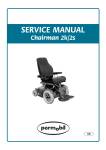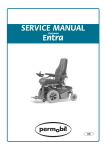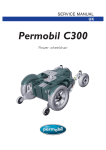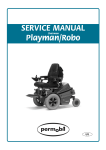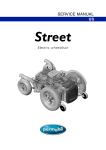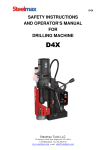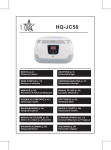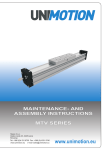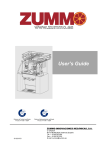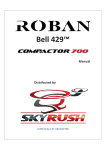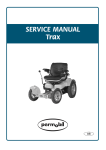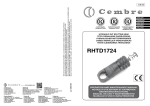Download SERVICE MANUAL
Transcript
SERVICE MANUAL Koala US How to contact Permobil Head Office of the Permobil group Produced and published by Permobil AB, Sweden Edition no.5, 2006-01 Article no.: 201164-US-0 Contents Contents Introduction.................................................................................................. Technical support...................................................................................... Spare parts ............................................................................................... Warranties ................................................................................................ Maintenance ............................................................................................. 5 5 5 5 5 Data Plates ................................................................................................... Chassis ..................................................................................................... Pilot Motor Controller................................................................................ Control panel ............................................................................................ 6 6 6 6 Operating the seat elevator manually ....................................................... 7 Covers........................................................................................................... 8 Batteries ....................................................................................................... 9 Drive wheels............................................................................................... 10 Brake release cables ................................................................................. 11 Brake release sensor................................................................................. 11 Magnetic brakes......................................................................................... 12 Drive motors............................................................................................... 13 Seat elevator .............................................................................................. Actuators ................................................................................................. Gas springs ........................................................................................... Slide bearings ........................................................................................ 18 18 19 19 Pilot Motor Controller................................................................................ 20 SLS drive stage & seat function board ................................................... 21 Control panel.............................................................................................. 22 Seat control panel ..................................................................................... 22 Circuit breaker and fuses ......................................................................... Circuit breaker ........................................................................................ Charge fuse ............................................................................................ Fuse for seat/lights ................................................................................. 23 23 24 24 Troubleshooting......................................................................................... 25 Distribution chart....................................................................................... 26 4 Introduction Introduction The Service Manual is intended for technical personnel who maintain and repair electric wheelchairs. It is important that anyone who performs maintenance and repairs described in this manual reads and understands the content of this manual so that the work is performed professionally. Always state the chassis number when contacting Permobil to ensure that the correct information is provided. Technical Support In the event of technical problems, you should contact your dealer, or Permobil Inc. USA at 800-736-0925. Spare parts Spare parts must be ordered through your dealer. Warranties Contact your dealer or Permobil Inc. USA for information about the warranties for this chair. Maintenance See the information in the Owner’s Manual. 5 Rating plates Data plates Chassis Fig. 1. Chassis identification number Pilot Motor Controller Fig. 2. Pilot Motor Controller identification number. Control panel Fig. 3. Control panel identification number. 6 Operating the seat lift manually Operating the seat lift manually If you can not move the seat up in the normal way, because the battery is flat or there is a fault (other than in the lift mechanism), you can raise the seat by using a cable, part number 308515-00-0. 1. Disconnect the connector in the lift mechanism cable. You can get to it from underneath, beside the rear fixing of the lift mechanism, see fig. 4. 2. Connect the cable to the lift mechanism and a battery or other voltage source, not exceeding 24 VDC. An ordinary 12V car battery is sufficient to operate the seat lift on a temporary basis. Fig. 4. Connecting the cable for emergency operation. If you do not have a cable for emergency operation, or the lift mechanism is faulty, you can raise the seat manually. 1. Remove the cushion from the seat. 2. Remove the seat plate, it is attached by three bolts, see fig. 5. 3. Remove the front fixing mechanism, see fig. 6. from the lift The seat is heavy. Exercise caution when the bolt is removed. Fig. 5. The seat plate is attached by three bolts. 4. Lift the seat manually to its highest position, lock the seat in the upper position using the safety stop. See fig. 7. Fig. 6. Lift mechanism front fixing. Fig. 7. Seat lift safety stop. 7 Covers Covers Removal 1. Raise the seat to its highest position. To operate the seat lift manually, see page 7. 2. Unscrew the two knobs that hold the front edge of the battery cover, see fig. 8. 3. Lift the battery cover at the front edge and move it backwards. Disconnect the connector in the cable to the anti-trap mechanism before you lift the cover off completely, see fig. 8. Fig. 8. The battery cover is attached by two knobs at the front edge. Be careful with the anti-trap mechanism cable. Use caution when you remove the battery cover. The anti-trap mechanism cable is attached to the electronic unit. 4. Remove the chassis cover. It is held by two screws at the front edge and two on either side, see fig. 9-10. Fig. 9. The chassis cover is attached by two screws at the front edge. Fitting Fitting is the reverse procedure. Fig. 10. The chassis cover is attached by two screws on either side. 9 8 Batteries Batteries On Use protective goggles when working on batteries. Off Removal 1. Put the wheelchair on a level surface. 2. Raise the seat to its highest position. To operate the seat lift manually, see page 7. 3. Switch off the main switch on the control panel. Fig. 11. Circuit breaker/Battery isolator. 4. Put the circuit breaker to the “OFF” position, see fig. 11. 5. Remove the battery cover, see page 8. Use caution when you remove the battery cover. The anti-trap mechanism cable is attached to the electronic unit. 6. Disconnect the battery terminals first, see fig. 12. leads, positive Fig. 12. Battery connections. 7. Remove the spacer plate at the front of the battery compartment by pulling it straight upwards, see fig. 13. 8. Lift out the batteries. Fitting Fitting is the reverse procedure. Fig. 13. Remove the spacer plate from the battery compartment by pulling it straight upwards. 9 Drive wheels Drive wheels Removal 1. Switch off the main switch. 2. Lift up the chair and support it on blocks, so that the wheels are off the ground. 3. Undo and remove the hubcap (6), bolt (3) and the three washers (1 and 2), see fig. 15. 4. Pull the wheel off the shaft. Use puller 304103-99-0 if the wheel is tight, see fig. 14. Fig. 14. Puller 304103-99-0. Fitting 1. Check the axle and rim for any damage. If necessary, you should clean these parts of dirt and rust. If any parts are damaged, they should be replaced. 2. Check that the key fits solidly in the keyway of the axle. If necessary, install the new key (4 or 5) and check for fit. 4 5 1 6 3 3. Lubricate the shaft with a thin layer of copper paste (Würth 0893800x, Art. no.: 1820540). 22 Warning! Do not use any type of lubrication in the threaded hole in the axle or on the bolt. If necessary, you should clean these parts. 4. Fit the wheel onto the axle. The use of hand force only is preferred, but, if need be, carefully use a rubber mallet, whose head diameter is no less than 1.5 inches (38 mm), to ensure that the rim is fully seated upon the motor. NB! Hitting too hard with a rubber mallet could cause damage to the gear. 5. Mount the three washers (1) and (2) onto the bolt (3) and secure the wheel. Use a torque wrench to tighten the bolt to 24 ft-Ibs (33Nm). Install the hub cap (6). See Fig. 14. 1. Washer, 8 HB 305 Fe/Zn 5 C2 (TBRSB 8,4x26x5) 2. Shim washer DIN 988 8 A2 (DB 8x14x0.5 Rostfri) 3. Bolt, ISO 4762 M8x25 10.9 Fe/Zn 5 C2 / Locking coat DIN 267-28 4. Key DIN 6885A 6x6x16 5. Key DIN 6885A 6x6x22 6. Hubcap Fig. 15. Wheel attachment. NB! The washer (1) should be placed with the most flat side inwards. NB! The bolt must be used once only. Removed bolt is not allowed to be refitted. Warning! Other types of bolts or washers are not to be used.. Warning! Do not use any other type of thread lock. 10 Brake release cables Brake release cables Removal 1. Raise the seat to its highest position. To operate the seat lift manually, see page 7. 2. Remove the battery cover and chassis cover, see page 8. 3. Remove the brake release mechanism, it is attached by two bolts, see fig. 16. 4. Slacken the locknut, see fig. 17:2. 5. Screw the see fig. 17:1. adjusting screw fully in, 6. Detach the cable at the magnetic brake and brake release mechanism. Fig. 16. The brake release mechanism is attached by two bolts. Fitting 1. Attach the cable to the brake release mechanism, then to the magnetic brake. 2. Adjust the length of the cable sleeve using the adjusting screw (17:1), so that the cable is tensioned but does not pull the release link. 3. Check the operation. Operate the brake release mechanism to release the brake and check that the wheel can turn. 4. Tighten the locknut (17:2). 5. Refit the brake release mechanism. 1 6. Refit the covers. 2 Brake release sensor Fig. 17. Brake release system. Removal 1. Raise the seat to its highest position. To operate the seat lift manually, see page 7. 2. Switch off the main switch on the control panel. 3. Put the circuit breaker to the “OFF” position, see page 23, fig. 52. 4. Remove the battery cover and chassis cover, see page 8. 5. Remove the brake release mechanism, it is attached by two bolts, see fig. 16. It is easier to remove the brake release sensor with the brake release mechanism removed. 6. Remove the brake release sensor, it is attached by two screws, see fig. 18. 7. Disconnect the connector in the brake release sensor cable. Fitting Fig. 18. The brake release sensor is attached by two screws. Fitting is the reverse procedure. 11 Magnetic brake Magnetic brakes Removal 1. Put the wheelchair on a flat surface. 2. Raise the seat to its highest position. To operate the seat lift manually, see page 7. 3. Switch off the main switch on the control panel. 4. Put the circuit breaker to the “OFF” position, see page 23, fig. 52. 5. Remove the battery cover and chassis cover, see page 8. 6. Disconnect the magnetic brake and drive motor electrical connectors, see fig. 19. Fig. 19. The magnetic brake and drive motor electrical connectors. 7. Pull the cable sleeve forwards and take the cable out through the slot in the cable mounting, Unhook the brake release cable from the magnetic brake, see fig. 20. 8. Raise the relevant side of the chair using the Permojack or raise the chair on blocks. 9. Remove the drive wheel on the relevant side, see page 10. Fig. 20. Remove the brake release cable. 10. Remove the three bolts that hold the drive motor, see fig. 21. Fig. 21. Drive motor fixing bolts. 12 Magnetic brake 11. Lift up the rear end of the drive motor to make it easier to remove the magnetic brake, see fig. 22. Fig. 22. Lifting up the rear end of the motor makes the magnetic brake more accessible. 12. Remove the three bolts that hold the brake, see fig. 23. Note the position of the brake release arm and rubber seal for refitting. Remove the brake, complete with the disc and cover. Fig. 23. Magnetic brake fixing bolts. 13 Magnetic brake Fitting 1. Use the adjusting screws to adjust the magnetic brake. Set both screws flush with back surface of the brake, then turn the screws downwards 1/8 turn, see fig. 24. Fig. 24. Use the two adjusting screws to adjust the brake. 2. Fit the brake disc into the magnetic brake. 3. Fit the cover. Fig. 25. Magnetic brake, brake disc, cover and rubber seal removed. 4. Insert a bolt (26:1) to align the parts. 1 2 Fig. 26. Use a bolt (1) to align the parts. 14 Magnetic brake 5. Fit the rubber seal, with the drainage hole at the bottom. Note the position of the brake release arm, fit the brake so that the brake release arm is aligned with motor cable mounting. Secure the magnetic brake using the three bolts. 6. Refit the drive motor, see fig. 21 on page 12. 7. Refit the drive wheel, see page 10. Fig. 27. Use one of the bolts to align the parts with one another. Fit the rubber seal. 8. Fit the brake release cable, see fig. 28. Fig. 28. Fit the brake release cable. 9. Connect the magnetic brake and drive motor electrical connectors, see fig. 29. 10. Fit the battery cover and chassis cover, see page 8. Fig. 29. Magnetic brake and drive motor electrical connectors. 15 Drive motor Drive motor On Removal 1. Raise the seat to its highest position. To operate the seat lift manually, see page 7. Off 2. Switch off the main switch on the control panel. 3. Put the circuit breaker to the “OFF” position, see fig. 30. 4. Remove the battery cover and chassis cover, see page 8. Fig. 30. Circuit breaker, 63A (Off-On). 5. Disconnect the drive motor and magnetic brake electrical connectors, see fig. 31. Fig. 31. Disconnect the electrical connectors. 6. Pull the cable sleeve forwards and take the cable out through the slot in the cable mounting. Unhook the brake release cable from the magnetic brake, see fig. 32. Fig. 32. Disconnect the brake release cable. 16 Drive motor 7. Remove the front battery, see page 9. 8. Raise the relevant side of the chair using the Permojack or raise the chair on blocks. 9. Remove the drive wheel on the relevant side the wheelchair, see page 10. 10. Remove the three bolts holding the motor. Fitting Fitting is the reverse procedure. When fitting a new motor, use the cable mounting from the old motor. Fig. 33. Drive motor fixing bolts. Fig. 34. Removing the drive motor. 17 Seat lift Seat lift Actuators Removal 1. Raise the seat to its highest position. To operate the seat lift manually, see page 7. 2. Switch off the main switch on the control panel. 3. Put the circuit breaker to the “OFF” position, see page 23, fig. 52. 4. Remove the battery cover and chassis cover, see page 8. 5. Remove the seat cushion and seat plate, see fig. 35. Fig. 35. The seat plate is attached by three bolts. 6. Remove the seat lift actuators front fixing bolt, see fig. 36. The seat is heavy. Exercise caution when the bolt is removed. 7. Lift the seat manually to its highest position. Ensure that the safety stop is in place, see fig. 37. 8. Disconnect the connector in the seat lift actuator cable. Fig. 36. Seat lift mechanism front fixing. 9. Remove the seat lift actuator rear fixing bolt, see fig. 38. Fitting Fitting is the reverse procedure. Fig. 37. Seat lift safety stop. Fig. 38. Seat lift actuators rear fixing. 18 Seat lift Gas springs There are gas springs built into the parallel tubes at the sides of the seat lift. These gas springs are part of the tilt mechanism. 1 Do not drill into the tube or gas spring, and do not expose them to heat, as this could cause an explosion. 2 Removal 1. Raise the seat to its highest position. To operate the seat lift manually, see page 7. Fig. 39. Parallel tube with gas spring. 2. Remove the battery cover and chassis cover, see page 8. 3. Switch off the main switch on the control panel. 2 4. Put the circuit breaker to the “OFF” position, see page 23, fig. 52. 1 5. Remove the bolt to detach the rear end of the spring, see fig. 39:2 and 40:8. Lock the pivot arm (40:2) by inserting a drift from underneath, through the hole in the end of the parallel tube. 7 6 6. Remove the circlip from the front attachment point, see fig. 39:1 and 40:3. 3 7. Remove the parallel tube complete with the gas spring. 8. Remove the socket head cap screw that locks the adjuster (40:1) and remove the tube. 4 5 1. Bolt, MC6S 2. Pivot arm 3. Circlip, SgA 16 4. Gas spring attachment 5. Spring tension pin, 8 x 18 6. Gas spring 7. Spring tension pin, 8 x 20 8. Bolt, 8 x 16 9. Drive out the spring tension pin (40:5) and remove the gas spring attachment (40:4). 10. Drive out the spring tension pin (40:7) and remove the tube. Fitting Fitting is the reverse procedure Fig. 40. Parallel tube with gas spring. Slide bearings Changing a bearing The basic procedure for changing a bearing is the same for all bearings 1. Remove the part where the bearing is to be changed. 2. Deform the bearing by driving a drift through the hole in the bearing seat, see fig. 41. Pull out the deformed bearing using pliers. 3. Clean the bearing seat and press, or carefully drive, in the new bearing. Turn the bearing so that the slot is aligned with the hole used when deforming the bearing, in order to make the next bearing change easier. Fig. 41. Hole for deforming the bearing. 4. Refit the part with the new bearing. 19 8 Pilot Motor Controller Pilot Motor Controller Removal 1. Raise the seat to its highest position. To operate the seat lift manually, see page 7. 2. Switch off the main switch on the control panel. 3. Put the circuit breaker to the “OFF” position, see page 23, fig. 52. 4. Remove the seat lift cover and chassis cover, see page 8. 5. Lift the Pilot Motor Controller out of its holder, see fig. 42-43. Fig. 42. The Pilot Motor Controller sits in its holder without any fixings. Fig. 43. Lift up the Pilot Motor Controller. 6. Disconnect the electrical connectors from the output stage; note their locations for refitting, see fig. 44. Fitting Fitting is the reverse procedure. Fig. 44. Electrical connectors for the Pilot Motor Controller. 20 SLS driver stage & Actuator control board SLS driver stage & Actuator control board The SLS driver stage and seat function board are mounted in the same box. When changing the seat function board, a new board is fitted into the existing box. When changing the SLS driver stage, the entire box is changed and the existing seat function board is moved to the new box. Removal 1. Raise the seat to its highest position. To operate the seat lift manually, see page 7. 2. Switch off the main switch on the control panel. Fig. 45. The box containing the SLS driver stage and the actuator control board is mounted on the left side of the chassis. 3. Put the circuit breaker to the “OFF” position, see page 23, fig. 52. 4. Remove the seat lift cover and chassis cover, see page 8. 5. Pull the lid off the box that contains the SLS driver stage and actuator control board, see fig. 45. 6. Remove the box that contains the SLS driver stage and actuator control board, it is attached by two screws from underneath, see fig. 46. Seat function board: 7. Remove the electrical connectors from the actuator control board, note their locations for refitting. 8. Remove the board from the box; it is attached by four plastic clips, see fig. 47. SLS driver stage: Fig. 46. The box containing the SLS driver stage and the actuator control board is attached by two screws from underneath. 9. Cut off the tie that holds the cable. 10. Disconnect the electrical connectors from the SLS driver stage; note their locations for refitting. Fitting Fitting is the reverse procedure. Fig. 47. The actuator control board is attached by four plastic clips. 21 Control panel Control panel Removal 1. 2. Switch off the main power switch on the control panel. Put the circuit breaker in the “OFF” position, see page 23, fig. 52. 3. Disconnect the control panel cable by pulling the connector at the rear of the control panel straight backwards. 4. To remove the control panel, remove the screws holding the common bracket for the control panel and Seat control panel, see fig. 48. Remove the control panel bracket by removing the two screws on the rear of the control panel, see fig. 49. Fig. 48. The Control panel and Seat control panel bracket. Fitting Fitting is the reverse procedure. Seat control panel Removal 1. 2. Switch off the main power switch on the control panel. Put the circuit breaker in the “OFF” position, see page 23, fig. 52. 3. Remove the cover of the Seat control panel by pulling it straight upwards. If the lid is stuck, you can carefully use a screwdriver to pry between the lid and the lower part of the end of the box, see fig. 50. 4. You can now lift the circuit board and cable out of the box. 5. Disconnect the cable from the circuit board by pulling the connector straight upwards, see fig. 51. 6. To remove the control panel, remove the screws holding the common bracket for the control panel and Seat control panel, see fig. 48. Remove the Seat control panel bracket by removing the two screws on the underside of the box, see fig. 49. Note the position of the bracket for refitting. Fig. 49 The Control panel and Seat control panel fixings. Fitting Fitting is the reverse procedure. Fig. 51. The Seat control panel electrical connector. Fig. 50. Removing the Seat control panel lid. 22 Circuit breaker and fuses Circuit breaker and fuses On Resetting the circuit breaker The circuit breaker also acts as a battery isolator, but is usually referred to as the circuit breaker. You will not normally need to change the circuit breaker, as you can reset it when it has tripped. It is located on the underside of the chassis, above the right, rear wheel, see fig. 52. The circuit breaker is protected from dirt and water by a rubber lip, which can easily be folded back. Off A tripped circuit breaker often means that there is a serious electrical fault. Check the cause thoroughly before you reset the circuit breaker. Fig. 52. Circuit breaker, 63A (Off-On). Changing the circuit breaker 1. Switch off the main switch on the control panel. 2. Put the circuit breaker to the “OFF” position, see fig. 52. 3. Remove the battery cover and chassis cover, see page 8. 4. Disconnect the battery positive lead, which is between the battery and the circuit breaker. 5. Remove the circuit breaker by removing the two screws, see fig. 53. Note the orientation of the circuit breaker for refitting. The ON/OFF positions must agree with the label. 6. Disconnect the cables from the circuit breaker by loosening the screws, see fig. 54. 7. Connect the cables to the new circuit breaker. Put the circuit breaker to the “OFF” position. Fig. 53. Circuit breaker, 63A. Check that the cables are fully secure. 8. Attach the new circuit breaker with the two screws, see fig. 53. Check the orientation of the circuit breaker. The ON/OFF positions must agree with the label. 9. Connect the battery positive lead. 10. Fit the battery see page 8. cover and chassis cover, Fig. 54. Circuit breaker electrical connections. 11. Put the circuit breaker to the “ON” position, see fig. 52. 23 Circuit breaker and fuses Changing the charge fuse The charge fuse is on the underside of the chassis, above the right, rear wheel, beside the circuit breaker, see fig. 55. Switch off the circuit breaker and the charger, if in use, before you change the charge fuse. The circuit breaker must be in the “ON” position during charging. Changing the seat/lights fuse There are two fuses in the SLS driver stage, F1 (unswitched) and F2 (switched). These protect two free outlets, which are located beside the SLS driver stage. One of the outlets (unswitched) supplies power irrespective of whether the chair is switched on or off. The other outlet (switched) supplies power only when the chair is switched on. Fuse F2 protects the seat and lights. Fig. 55. Charge fuse, 15A. 1. Remove the seat lift cover and chassis cover, see page 8. 2. Pull the lid off the box that houses the SLS driver stage, see fig. 56. Fig. 56. The box containing the SLS driver stage and the actuator control board is mounted on the left side of the chassis. 3. Change the blown fuse, see fig. 57. 4. Put the lid back on the box. 5. Refit the covers, see page 8. F1 F2 Fig. 57. F1 = 24V unswitched 15A. F2 = 24V switched 15A, Seat/Lights. 24 Troubleshooting Troubleshooting Battery voltage indicator The battery voltage indicator shows the status of the wheelchair. Steady Display Flashing slowly Flashing quickly - Everything is working correctly. - The batteries need to be charged. - Fault signal. A fault has occurred and the wheelchair can not be driven. Fault signals The number of flashing lights indicates the fault. – Note the number of flashing lights. – Switch off the chair. – Switch the chair back on. – If the fault is still there, count the number of flashing lights, then look up the possible cause and action in the table below. CAUSE High battery voltage LEDs ACTION 10 Check the battery and the connections between the battery and Pilot Motor Controller. Break in the brake circuit 9 Check the connections to the magnetic brake. Fault in the electronics 8 Check the connections to the Pilot Motor Controller. If the fault persists, change the Pilot Motor Controller Fault in the control panel 7 Make sure the joystick isn’t actuated at switchon, change the control panel. 6 Short circuit, right drive motor 5 Check the motor connections and cable. Open circuit, right drive motor 4 Check the connection to the right drive motor. Short circuit, left drive motor 3 Check the motor connections and cable. Open circuit, left drive motor 2 Check the connection to the left drive motor. Low battery voltage 1 Check the condition of the battery. Check the connection between the battery and the control unit. 25 Distribution chart 1 2 3 A B C D E F 26 4 Distribution chart 5 6 7 8 A B C D E F Distribution chart 27 Notes 28 Notes 29 Notes 30 Article no.: 201164-US-0
































